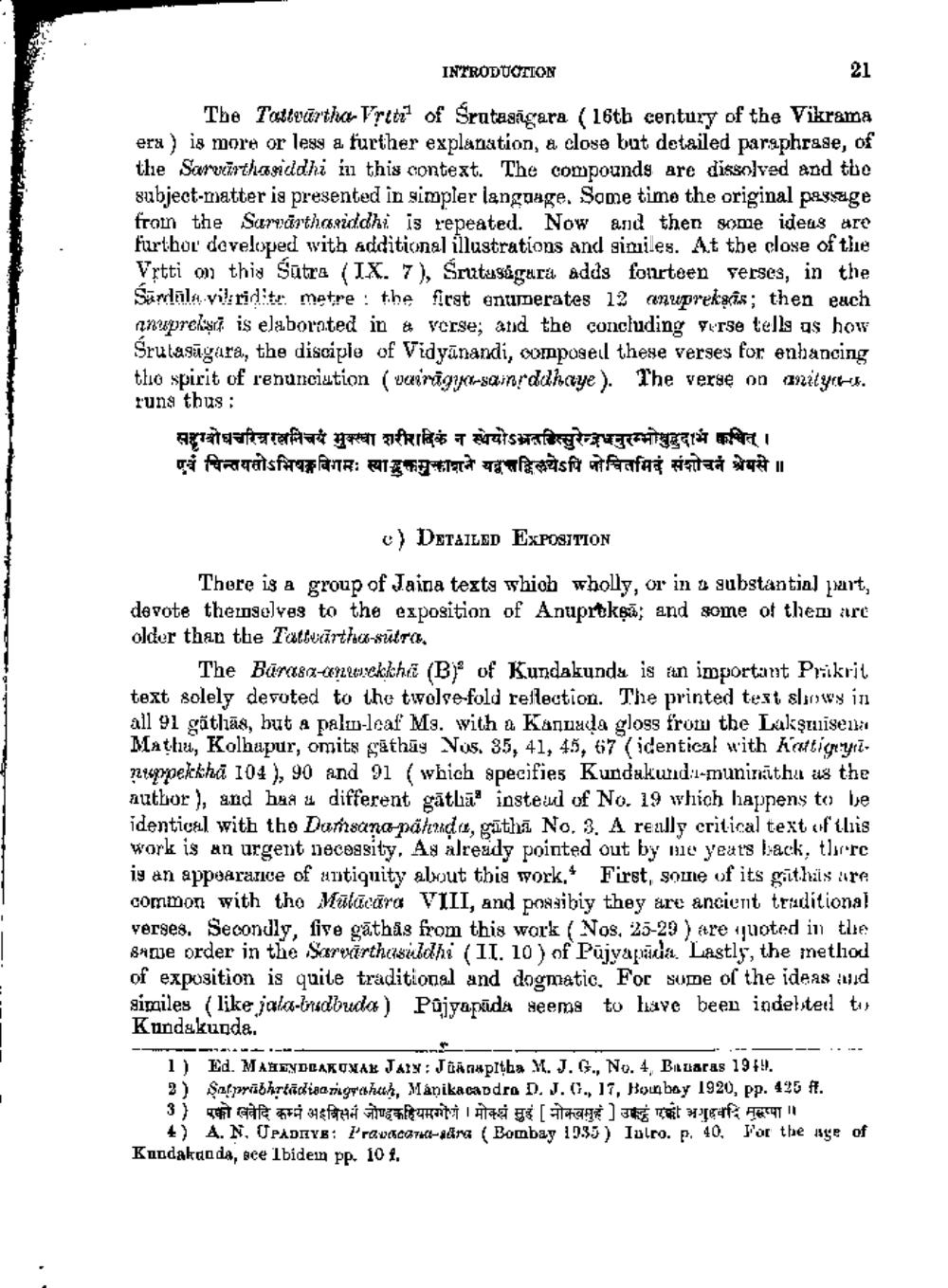________________
INTRODUCTION
The Tattvartha Vrtti of Śrutasigara (16th century of the Vikrama era) is more or less a further explanation, a close but detailed paraphrase, of the Sarvarthasiddhi in this context. The compounds are dissolved and the subject-matter is presented in simpler language. Some time the original passage from the Sarvarthasiddhi is repeated. Now and then some ideas are further developed with additional illustrations and similes. At the close of the Vrtti on this Sutra (IX. 7), Śrutasågara adds fourteen verses, in the Sandals viridite metre: the first enumerates 12 anupreksas; then each anupreis is elaborated in a verse; and the concluding verse tells us how Śrutasugara, the disciple of Vidyanandi, composed these verses for enhancing the spirit of renunciation (vairagya-samṛddhaye). The verse on anitya-a. runs thus:
21
सम्बोधचरित्ररखनिचयं मुक्रवा शरीरादिकं न स्थेयोऽतसुरेन्द्रधनुरम्भोदाभं कचित् । एवं चिन्तयतोऽभिषक विगमः स्याद्भुक्तमुकाशने याहिलयेऽपि नोचितमिदं संशोचनं श्रेयसे ॥
c) DETAILED EXPOSITION
There is a group of Jaina texts which wholly, or in a substantial part, devote themselves to the exposition of Anuprtks; and some of them are older than the Tattvartha-sutra.
The Barasa-antrekkha (B) of Kundakunda is an important Prakrit text solely devoted to the twelve-fold reflection. The printed text shows in all 91 gathas, but a palm-leaf Ms. with a Kannada gloss from the Laksmisena Matha, Kolhapur, omits gathas Nos. 35, 41, 45, 67 (identical with Kettigey nuppekkhā 104), 90 and 91 (which specifies Kundakunda-muninātha as the author), and has a different gatha instead of No. 19 which happens to be identical with the Damsana pähuda, gatha No. 3. A really critical text of this work is an urgent necessity. As already pointed out by me years back, there is an appearance of antiquity about this work. First, some of its gathis are common with the Malacara VIII, and possibly they are ancient traditional verses. Secondly, five gathas from this work (Nos, 25-29) are quoted in the same order in the Sarvarthasiddhi (II. 10) of Pujyapada. Lastly, the method of exposition is quite traditional and dogmatic. For some of the ideas and similes (like jala-budbuda) Pujyapāda seems to have been indebted to Kundakunda.
1) Ed. MAHENDRAKUMAR JAIN: Juanapitha M. J. G., No. 4, Bauaras 1949.
2) Satprabhṛtadisamgrahah, Manikacandra D. J. G., 17, Bombay 1920, pp. 425 ft.
3) एको खवेदिकम् अविसनं जोण्डकहियमग्गं । मोक्शं सुई [ नोक्खमुहं ] उपलं की अगुवदि मुरूपा ॥
4) A. N. UPADHYE: Pravaca-dra (Bombay 1935) Iatro. p. 40. For the age of Kundakanda, see lbidem pp. 10 f.




